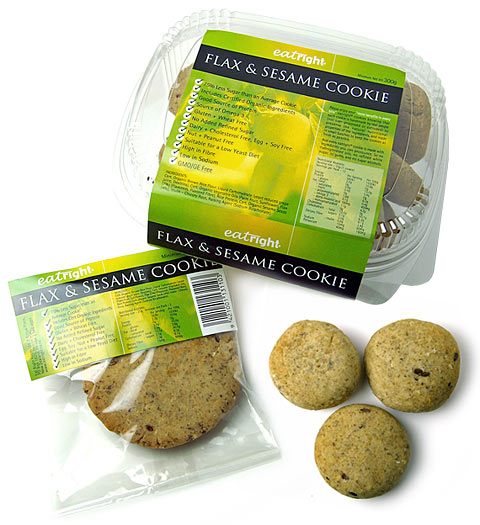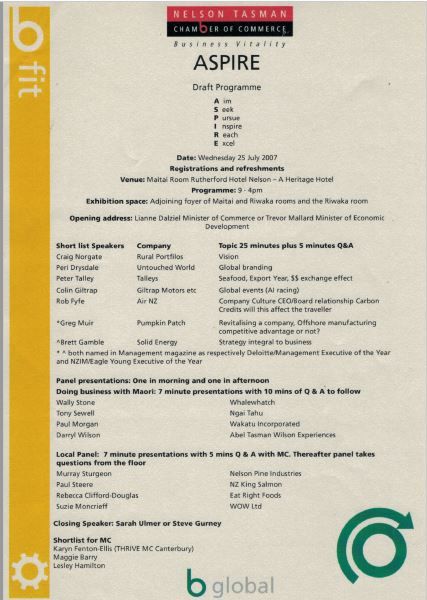Flax & Sesame *Re:VISION* (Cookie, Cracknel, Pattie)
Rising from the ashes [†] is the EATRIGHT®, very versatile, Flax and Sesame Cookie. Also known as the EATRIGHT® Flax and Sesame Cracknel [1] or a Flax & Sesame 'Vegetable Pattie' due to its wide range of usefulness and/or instore location adaptability. This product is a good example of Eat Right Food's (ERF) More Benefits in Every Bite™ Foodarmacy™ foray with ERF re:leading this disruptive category creation.
◊ 75% less sugar than an average cookie
◊ Good source of plant protein and 'improvement of protein quality'
◊ Suitable for a low yeast diet [2]
◊ Source of Omega-3
◊ Source of prebiotic and probiotic inulin [^]
◊ Source of no beet or wheat 'essential' guanine [*]
◊ High in fiber; high in fibre
◊ No (-xanthin) ‘color added’
◊ No added refined sugar
◊ No added (CO2 releasing) aeration agents
◊ No graff (fortification...moat (Merriam-Webster))
◊ Low in sodium-salt: reduces blood pressure
◊ GMO/GE/BE free
◊ Includes certified organic ingredients
Ingredients: Cert. organic brown rice flour [3], liquid carbohydrate (yeast reduced grape juice [4][5], dextrins), cert. organic vegetable oils (palm [6], safflower [7]), cert. organic flax (7%) (whole seeds and ground fiber) [8], brown rice protein, cert. organic unhulled subtropical sesame (4%) (whole seeds and cold presses oil), cert. organic chicory root
Contains: sesame
Nutritionals per small cookie 25g serving size:
Energy 383kJ, Protein (2.7g), Protein-gluten (0g), Fat-total (3.8g), Fat-sat (0.9g), Fat-trans (0g), Fat-poly unsat (1.6g), Fat-omega 3 (0.1g), Fat-alpha-linolenic acid (100mg), Fat-monounsat. (1.1g), Cholesterol (0g), CHO-total (12.5g), CHO-sugars (2.1g), dietary fiber (2.0g), inulin (0.9g) [^], sodium (<15mg), potassium (40mg)
Dietetic Products, Nutrition and Allergies [European Food Safety Authority Unit (EFSA)] Consolidated list of Article 13 (pub. Apr’11)
ID 2076, ID2294: “Linum usitatissimum (Common Name : flaxSEEd linSEEd)” for “Gut health, Control of weight”. (n/a: Phomium tenax)
ID 2156-9, ID2727: “Vitis vinifera (Common Name : Grape)” for “Antioxidant properties, Vein health, Skin health/Antioxidative properties and Heart health, Weight control”
ID 2416, ID2701-2: “Cichorium intybus (Chicory)” for “Heart health / Vascular health, Urinary elimination, Slimming aid/ Weight control"
ID 2913: “L-methionine” and “Improvement of protein quality. Modulation of lipids metabolism”. Methionine sources: rice, grape (>220ppm), flax, sesame (>3120ppm)
ID 2922: “Inulin/oligofructose from chicory” for “Satiety”. See also “Native chicory inulin contributes to normal bowel function by increasing stool frequency”
Choline Content of Common Foods (USDA release 2. Jan'08) (SEEds, sesame SEEd kernels, dried (decorticated)) 26mg/100g, (brown, long-grain, cooked): 9.2mg/100g (flour n/a), SEEds, flaxsSEEd 79mg/100g, Grape juice, canned or bottled, unsweetened, without added vitamin C: 3.2mg/100g. See also Dr Duke Database 2016. PhytochemID: choline: Chicory root.
Country of Origin: Made in NEW ZEALAND from NEW ZEALAND and imported ingredients
Detail: Food Safety Verification Certificate Number 2699 (an International Accreditation NEW ZEALAND (IANZ) inspection body audit, pursuant to the Food Act 2014) issued to Eat Right Food Ltd for the manufacture, processing, exporting, packing, holding and distribution of food products
Synonyms: EATRIGHT® Linseed and Tahini Cracker, Linum usitatissimum L. & Sesamum indicum L. Biscuit, Plant Protein Pattie, Flax Sesame 'Rice-Cake'
Availability: Currently an EATRIGHT® online only product
Use-by-date: Eighteen months. Store-age location: freezer
Address: PO Box 1525 (Level 1, 6 Church St), Nelson. Zip code: 7040, NEW ZEALAND
PS. Develop Sept'06, hold Sept'08, reignited Jan'23
PPS. Included in "RADICAL New Products Customer Survey" Feb'07, re-submitted Feb'15. An example of our ongoing TPP [technology product and process] innovations
PPPS. 'Allergy foods lead the world'. NEW ZEALAND Food Technology (pub. 2007) [††]. "Spiralling demand...market niche...market leader in developing foods for specific groups...responsiveness...Mrs Clifford-Douglas says...Eat Right Foods products remain unique". Follow on article 'Connecting the DOTS' "...barcoding and other technologies...to patient bedside. Radio frequency identification (RFID)...launch of EPC-IS...GS1" [This article, from endex.co.nz, doesn't appear to be archived]. Compare to "medical costs spiraling out of control" [anticipatory, May'15]. NB. RFID not RFI [†††]
PPPPS. 13th Oct'22 meeting with GS1 NZ, now aware of [test program, May 2019] 'Woolworths Australia already working...to roll out (2-dimensional) 2D barcodes'. 'Container ONLY, no biscuits [ie no product content photos permitted] on the outside' re: IShop App 'Oct'18. GS1 NZ Apr'16 acquisition of Images in SPACE Limited (900841)'photographs...products...correct formats for advertising, space management planograms and on-line stores...authorized by Progressive' (Jan'10) and 'Progressive have provided us with a list of products that are missing an image from their home shopping website' (Jul'07). But, "clear container is difficult to photograph and with white background it always gets blue-isch...why I put it on the table (wood)" (Cactus Software, Oct'05)
Product Details
- [1] crack'nel n., crisp soft (savoury) biscuit of powdery consistency. Definitions from Oxford Languages (dictionary box) and Pocket Oxford Dictionary 4th Ed.
- [2] Higher level food claim requirements: 'substantiate claims through scientific or recognized traditional evidence'. See similarities to medical device requirements class III: extensive clinical trials, class II: similar to existing technology, class I: no testing
- AntiUTI (urinary tract infection): mannose. Plant source: chicory root (USDA data). ID 2701: “Chicory (Cichorium intybus L.)” and “Urinary elimination”. EFSA Dietetic Products, Nutrition and Allergies, article 13 health claims (pub. Apr'11)
- Biological Activity: Ophthalmic (relating to the eye and its diseases) - antialkali. Phytochemical: Cysteine. Sources: Carrot, Flaxseed and Rice.
- Antiretinitic optometry and retinoprotectant optometry activity: grape (14ppm). Phytochem: lutein, present in grape (0.7-7ppm) and rice. (EFSA Qualified Health Claim:- Lutein and Eye Diseases Docket No. 2004Q-0180)
- EFSA ID 2888: “zeaxantin” (zeaxanthin) and “helps to preserve elasticity and permeability of capilars of retina and supports good blood circulation in eyes” PhytochemID: Zeaxanthin. Fruit source: GRAPE. Dr Duke Phytochemical Data
- Biological Activity: Previtamin-A. Alpha-carotene and Gamma-carotene (grape)
- Biological Activity: Antialkali? Phytochemical. Glutamic-acid. Dosage 500-1,000mg/day/orl/man. Sesame 103,854ppm. Grape 14,198ppm. Flaxseed. Rice. Dr Duke's Phytochemical and Ethnobotanical Databases (pub. 2016)
- [3] Rice. Seed source of calcium. 71ppm (low), 364ppm (high) Antiallergenic, hypocholesterolemic 500mg/day (Healing with Food by Werbach, M. 1993) et al
- [*] Bioactivity: 'ESSENTIAL'. Non ubiquitous chemical: guanine. Source: rice. Dr Duke USDA Database.
- [4] Candida SAP (secreted acid proteases) inhibitor. PhytochemID: Ellagic-acid. Ubiquitous NO. Vitis vinifera (grape). Antiyeast IC50=10.5uM. Candida-SAP-inhibitor IC50=8.4uM Dr Duke's Phytochemical and Ethnobotanical Databases
- [5] Ethnobotany Use: *Blindness*. Vitamin-A-Activity. Grape. Phytochemical: Cryptoxanthin. Ubiquitous NO. Ethnobotany Use: Intellect. Grape (Shih-chen, Li. 1973. Chinese medinal [medicinal] herbs. Georgetown Press). Dr Duke's Phytochemical, Ethnobotanical Database
- [6] From the 'fruit’s mesocarp of Elaeis guineesis palm', sustainably sourced. Source of tocotrienol (antioxidant) vitamin E (alpha-tocotrienol 100-165ppm, beta-tocotrienol 45-75ppm and gamma-tocotrienol 220-360ppm). Vitamin E, alpha-tocopherol equivalents 26mg/100g.
- Elaeis guineesis (African Oil Palm): anti-cataract activity (phytochemIDs: Alpha-tocopherol, Ascorbic-Acid 350 mg/day, Niacin, Riboflavin 15 mg/day, Thiamin). Natural source of vitamin A and not 'VITAMIN A PALMITATE' [extracted salt or ester of palmitic acid (component of palm oil)]. NB. Organic Palm Oil sustainability documents, supplier provided.
- [7] Safflower (Carthamus tinctorius L.) Activities: Calcium Antagonist (1; WO3; X8281577), Anticataract (alpha tocopherol 449ppm) Ref: Duke, James A. 1992 'Handbook of Medicinal Herbs' and online database
- [8] Flax; LinSEEd. Chemicals w/activities: calcium 1820-7400ppm stdDev 0.6 (antiallergic 500mg/day) Antiallergenic: White and Mavor (1998). A phytochemical has shown the activity or proven experimentally
- PhytohemID: Silicia. Ubiq. NO. Flaxseed 322-608ppm. 'Silica strengthens bones, hair, nails' White et al, '00. Chemistry of silica & potential health benefits; Martin KR, 2007 [see also EFSA ID 2723 “Bones and joints health” and 'isolated silica compounds from horsetail for the treatment of bone fractures, osteoporosis, CONNECTive tissue, tooth and nail injuries
- Activities (sesame): Demulcent (f; EFS; FEL; KAB); Dentifrice (f; DAA); Emollient (f; KAB; SKJ; WOI). Activities (flaxseed): Demulcent (pectin: 53,900-100,000 ppm [deferred claim: 'reduces blood glucose rise after a meal']; mucilage: 20,000-84,000ppm)
- Sesame ‘combined with linseed, the SEEd decoction is used as an aphrodisiac… more doctors take vitamin E than prescribe it’ (vitamin E, tocopherol, RDI = 15mg/day). CRC handbook of medicinal spices / James A. Duke…[et al.] (pub. '02)
- [†] PhytochemID: Ash. Ubiquitous YES. Rice 6,5450-75,060ppm. Grape 4,290-77,000ppm. See also charred bamboo poultice use for burns (Samoa [and Navua River, Fiji]). DrDuke Phytochemical, Ethnobotanical Databases
- PhytochemID: Trans-ferulic-acid. Ubiquitous NO. Flaxseed 375ppm, sesame seeds 5-40ppm. Biological activities: antioxidant, cancer-preventative. “Ferulic acid has antiallergic, broad cardiovascular, and hematologic effects (antiplatelet aggregation, antithrombic, etc.) as well as inhibitory effects on lipid peroxidation” (Encyclopedia of Common Natural Ingredients by Khan and Abourashed (3rd ed)
- Rice plant sources of phytochemicals: Anthera-xanthin, hypo-xanthine, neo-xanthin, tara-xanthin, viola-xanthin, xanthine. Dr Duke's Phytochemical and Ethnobotanical Databases
- Bioactivity: demulcent. Sources: Flax (mucilage: 20,000-84,000ppm, pectin 53,900-100,000ppm, sucrose 388ppm), Sesame (sucrose ppm n/a), Grape (pectin 300-3,900ppm), Chicory, Rice (9,600ppm) Phytochemical Dictionary. A Handbook of Bioactive Compounds from Plants. by Jeffery B. Harborne and H. Baxter (eds. 1983) and additional data
- [§] 'suggests heavy consumption of certain spices when estrogen levels are down. Seeds like…sesame all contain phytoestrogens, as do their oils’. Sesame estrogenic phytochemicals: beta-sitosterol, boron (3mg/MAN/day), stigmasterol. Weed S.S., New Menopausal Years, Wise Woman Way, Ash Tree Pub. '02; Handbook of Medicinal Spices
- HEMOSTATs: cellulose (chicory (root) 50,000ppm, flax (SEEd) 93,000-147,000ppm, rice (petiole, plant) 190,000-534,600ppm), quercitrin (grape), tannic acid (sesame SEEd), cephalin (sesame SEEd 133,168-233,856ppm). (food not surgical clamp or forceps). Dr Duke's Phytochemical, Ethnobotanical Databases
- Linseed source of: phenolic acid: 810ppm-103,400ppm, phenolic acid esters: 739ppm-5,420ppm Sesame seed source of: 2-methoxy-4-vinyl-phenol, P-methoxy-phenol
- [^] Inulin (ADI(diagnostic)=50mg/kg/ivn/man). Activities: Antidiabetic, Prebiotic, Probiotic, Probiotigenic, Bifidogenic, Lipolytic, Immunostimulant, Chemopreventative (Breast & Colon Cancer) (ref. USDA Dr. Duke's Databases) 'Lignans [flaxseed 525-675ppm] have antileukemic, antilymphomic, antimutagenic, and antitumor activities' Ref: (FNF) Father's Nature's Farmacy (www.ars-grin.gov/duke/) page n/a
- [1] Two new quinochalcone yellow pigments from Carthamus tinctorius and Ca2+ antagonistic activity of tinctormine
by Meselhy MR et al. (pub. Oct'93).
- [††] Success Story (Allergy Foods Lead the World). Market New Zealand (pub. Jun'07). 'A link will be sent to...subscribers'.
Story written by Katherine Edmond, Media Writer, NZTE. Photo credit: Grant Stirling (stirlingimages.com)
- [§] Vegetarian / vegan frozen snacks +31.2%. Total frozen +7% [of which, 26% was private label], shelf-stable +5.6% growth
NZ Food Awards, F&B Connect, May'18. Countdown/Progressive Enterprises slide/information. Comprehensive report available to purchase from © Information Resources, Inc. State of the Nation 2017.
- [§] 'Dietary sesame seeds elevate the concentrations of both tocopherols and tocotrienols in adipose tissue and skin, but not in plasma or other tissues (X11694614)'
Handbook of Medicinal Spices by Dr J.A. Duke et al (pub. 2003)
- [§] ‘Carotenoids lutein (L), zeaxanthin (Z), and meso-zeaxanthin (MZ) accumulate in the central retina, where they are collectively known as macular pigment (MP)… important for optimal visual performance, because of its BLUE light-FILTERing’.
What is meso-zeaxanthin, and where does it come from? by Nolan JM, Meagher K, Kashani S, Beatty S. (pub. Aug 2013)
- [§] ‘Rice merchants in Osaka, Japan, had already set up the world’s first futures market. The idea of forward trading is said to have originated around 1620’
Reinventing the Bazaar a Natural History of Markets by John McMillan (pub. 2002), Study Notes by Zhipeng Yan (created Jan’07, modified Dec’07)
- The chemistry of silica and its potential health benefits
by Martin KR (pub. 2007) J Nutr Health Aging, 11, 94-97
- [†††] 'Financial UNDERWRITERs'...Botanical Adulterants Prevention Program [excl. 'hard-to-find specialty' horopito, kawakawa, harakeke]
'RFI Ingredients, LLC' was a potential 'manufacturer' to 'ERF' (correspondence Apr'13). Submitted to another relevant 'financial underwriter' organization Mar'15 (RFP No. 45)






